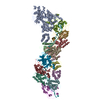+Search query
-Structure paper
| Title | Type-III-A structure of mycobacteria CRISPR-Csm complexes involving atypical crRNAs. |
|---|---|
| Journal, issue, pages | Int J Biol Macromol, Vol. 260, Issue Pt 2, Page 129331, Year 2024 |
| Publish date | Jan 11, 2024 |
 Authors Authors | Hongtai Zhang / Mingmin Shi / Xiaoli Ma / Mengxi Liu / Nenhan Wang / Qiuhua Lu / Zekai Li / Yanfeng Zhao / Hongshen Zhao / Hong Chen / Huizhi Zhang / Tao Jiang / Songying Ouyang / Yangao Huo / Lijun Bi /  |
| PubMed Abstract | Tuberculosis (TB), a leading cause of mortality globally, is a chronic infectious disease caused by Mycobacterium tuberculosis that primarily infiltrates the lung. The mature crRNAs in M. ...Tuberculosis (TB), a leading cause of mortality globally, is a chronic infectious disease caused by Mycobacterium tuberculosis that primarily infiltrates the lung. The mature crRNAs in M. tuberculosis transcribed from the Clustered Regularly Interspaced Short Palindromic Repeats (CRISPR) locus exhibit an atypical structure featured with 5' and 3' repeat tags at both ends of the intact crRNA, in contrast to typical Type-III-A crRNAs that possess 5' repeat tags and partial crRNA sequences. However, this structural peculiarity particularly concerning the specific binding characteristics of the 3' repeat end within the mature crRNA within the Csm complex, has not been comprehensively elucidated. Here, our Mycobacteria CRISPR-Csm complexes structure represents the largest Csm complex reported to date. It incorporates an atypical Type-III-A CRISPR RNA (crRNA) (46 nt) with 5' 8-nt and 3' 4-nt repeat sequences in the stoichiometry of Mycobacteria Csm12345 The PAM-independent single-stranded RNAs (ssRNAs) are the most suitable substrate for the Csm complex. The 3'-repeat end trimming of mature crRNA was not necessary for its cleavage activity in Type-III-A Csm complex. Our work broadens our understanding of the Type-III-A Csm complex and identifies another mature crRNA processing mechanism in the Type-III-A CRISPR-Cas system based on structural biology. |
 External links External links |  Int J Biol Macromol / Int J Biol Macromol /  PubMed:38218299 PubMed:38218299 |
| Methods | EM (single particle) |
| Resolution | 3.1 - 3.73 Å |
| Structure data | EMDB-37499, PDB-8wfx: EMDB-38066, PDB-8x5d: |
| Source |
|
 Keywords Keywords | RNA BINDING PROTEIN/RNA / Csm effector complex / Mycobacterium canettii / Cryo-EM structure / Csm1 / Csm2 / Csm3 / Csm4 / Csm5 / RNA BINDING PROTEIN / RNA BINDING PROTEIN-RNA complex / Mycobacteria CRISPR-Csm complexes |
 Movie
Movie Controller
Controller Structure viewers
Structure viewers About Yorodumi Papers
About Yorodumi Papers







 mycobacterium canettii (bacteria)
mycobacterium canettii (bacteria)